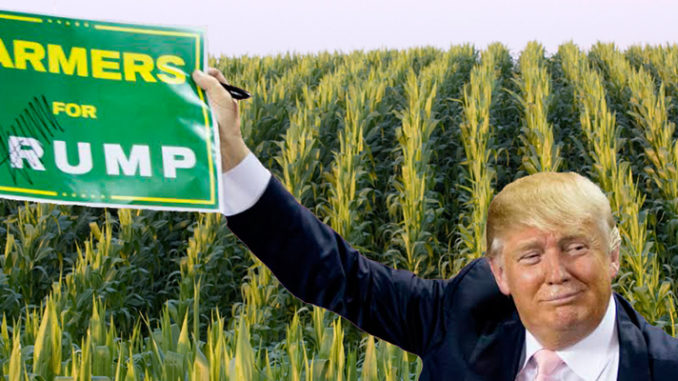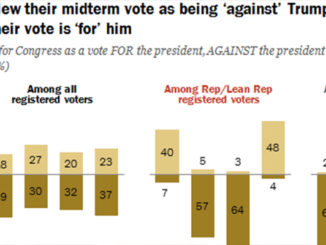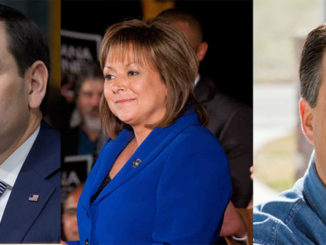
by Philip Bump
The popular understanding of what “socialism” entails isn’t quite right. We tend to use the expression interchangeably with “social programs,” government investments in aid to the American public. In other contexts, it’s used as a blanket pejorative. The Democrats want socialism, President Trump will say, part of his effort to tap into his base’s latent Cold War worries.
Trump’s party has consistently framed itself in opposition to big government spending, an idea that bleeds over into this nebulous socialismness, particularly as elections near. Democrats want to tax and spend; Republicans believe in the free market. That sort of thing. Cut spending, cut taxes, everyone wins.
While Trump doesn’t always hew to this line of rhetoric from his party, he does at times. As with his administration’s plan to change eligibility requirements for food stamps, reported on Tuesday.
In most states, people who are eligible for assistance under the Temporary Assistance for Needy Families program are also then eligible for food stamps (technically, the Supplemental Nutrition Assistance Program). By eliminating that automatic registration and requiring a separate application for food stamps, the government figures that it can eliminate more than 3 million people from the ranks of those receiving the aid.
Net savings? According to Reuters: $2.5 billion annually, or as much as $15 billion over the long term. To put that into perspective, the tax cuts signed into law by Trump in December 2017 contributed to a net decrease in corporate tax receipts of more than $90 billion by the nd of fiscal year 2018.
We can put it into perspective in another way, too, thanks to a tweet from Trump on Tuesday morning.
Farmers are starting to do great again, after 15 years of a downward spiral. The 16 Billion Dollar China “replacement” money didn’t exactly hurt!
— Donald J. Trump (@realDonaldTrump) July 23, 2019
Farmers, Trump says, are doing great again after seeing their fortunes fall for 15 years. Why? Well, thanks in part to something he calls “replacement money.”
This is a euphemism for one of the most direct government handouts in recent memory.
After Trump initiated a trade war with China by imposing tariffs on imports, the Chinese retaliated by adding tariffs of their own, targeting American agricultural products. Sales of crops such as soybeans plunged, putting farmers at direct economic risk.
In order to offset that, the administration introduced a subsidy program that will pay farmers to keep them in business. Trump claimed at one point that this subsidy would come from the tariffs being paid by China on imported products but, as you likely know, those tariffs are also being paid largely by American consumers.
The subsidy program’s cost? $16 billion. The amount of increased costs borne by Americans through June of this year? That’s estimated at more than $22 billion.

So Trump is, in essence, taxing American consumers to pay $16 billion to farmers. The rationale for this is simple, as is the rationale for Trump bragging about handing that money over to farmers: 2020. Farmers almost necessarily live in more rural areas, places that are a stronghold of Trump’s support. Trump is reminding farmers and those who live near farmers that he’s delivering for them, no matter how at odds with his party’s past rhetoric
You’ve probably already made this comparison in your head, but let’s do so explicitly. Trump’s administration wants to change food-stamp eligibility rules in order to save $15 billion over the long run and reduce food aid to 3.1 million people. At the same time, he celebrates spending $16 billion over the short run to bolster 3.4 million American farmers — who were hurting in part because of the tariffs that he himself imposed.
All of this is occurring in the shadow of the broad tax cuts he signed in 2017 that have contributed to what the White House itself expects to be a $1 trillion deficit this fiscal year.
Trump’s use of federal funds to send political messages is pretty explicit here. Poor people shouldn’t be poor in this economy and don’t need food stamps. Farmers do need assistance (thanks to Trump), and that assistance is worth bragging about.
If you’re curious, 39 percent of households receiving food stamps in 2016 were run by someone who is white. Well over 90 percent of farmers are white.
Again, this isn’t really socialism, as such. But, then, neither are many of the proposals from Democrats that Trump regularly disparages. While he’s more receptive to using government money to bolster his political base than many in his party, he still likes to use the word “socialism” as a cudgel.
It seems safe to say, though, that he won’t apply that word to his support for farmers.



